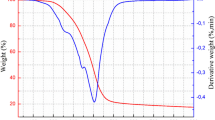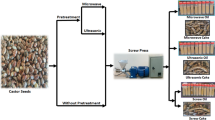Abstract
The aim of this study was to increase the efficiency of rapeseed oil recovery by pressure shockwaves and to asses the changes related to energetical utilization of the seedcake obtained. Mass balances and several design parameters (along with their manifestations on the seedcake) were analyzed to allow further optimization of the technology. It was found that the use of pressure shockwaves, in combination with the mechanical expeller, may increase oil yields up to the theoretical 100 % maximum, or alternatively reduce expeller energy requirements while maintaining the same oil yield. Decreased amounts of oil in the seedcake correlate with reduced amounts of volatile matter, which means lower quantities of hazardous fumes generated during direct combustion. In addition, higher levels of seedcake disintegration accelerated the biogas production.






Similar content being viewed by others
References
Ammar JB, Lanoiselle JL, Lebovka NI, Van Hecke E, Vorobiev E (2010) Effect of a pulsed electric field and osmotic treatment on freezing of potato tissue. Food Biophys 5:247–254
Antonopoulou G, Stamatelatou K, Lyberatos G (2010) Exploitation of rapeseed and sunflower residues for methane generation through anaerobic digestion: the effect of pretreatment. Chem Eng Trans 20:253–258
Dong M, Walker TH (2008) Characterization of high-pressure carbon dioxide explosion to enhance oil extraction from canola. J Supercrit Fluid 44:193–200
Fernández MB, Perez EE, Crapiste GH, Nolasco SM (2012) Kinetic study of canola oil and tocopherol extraction: parameter comparison of nonlinear models. J Food Eng 111:682–689
Fornari T, Vicente G, Vázquez E, García-Risco MR, Reglero G (2012) Isolation of essential oil from different plants and herbs by supercritical fluid extraction. J Chromatogr A 1250:34–48
Grémy-Gros C, Lanoiselle JL, Vorobiev E (2009) Application of high-voltage electrical discharges for the aqueous extraction from oilseeds and other plants. In: Vorobiev E, Lebovka N (eds) Electrotechnologies for extraction from food plants and biomaterials. Food Engineering Series. Springer, New York, pp 217–235
Guderjan M, Elez-Martinez P, Knorr D (2007) Application of pulsed electric fields at oil yield and content of functional food ingredients at the production of rapeseed oil. Innov Food Sci Emerg Tech 8:55–62
Higa O, Matsubara R, Higa K, Miyafuji Y, Gushi T, Omine Y, Naha K, Shimojima K, Fukuoka H, Maehara H, Tanaka S, Itoh S (2012) Mechanism of the shock wave generation and energy efficiency by underwater discharge. Int J Multiphys 6:89–98
Itow K, Murakami T, Shimada R, Hiraki H (1998) Electric discharge shock breakdown apparatus for reinforced concrete member and method therefor. JP Patent No. WO98/07521
Kartika IA, Pontalier PY, Rigal L (2005) Oil extraction of oleic sunflower seeds by twin screw extruder: influence of screw configuration and operating conditions. Ind Crops Prod 22:207–222
Kotov JA, Korzhenevskij SR, Motovilov VA, Filatov AL, Korjukin BM, Boriskov FF (2000) Process and plant for selective opening of thin inclusion of solid material. RU Patent No. 2150326
Lee HY, Uhm HS, Choi HN, Jung YJ, Kang BK, Yoo HC (2003) Underwater discharge and cell destruction by shockwaves. J Korean Phys Soc 42:880–884
Maroušek J, Itoh S, Higa O, Kondo Y, Ueno M, Suwa R, Komiya Y, Tominaga J, Kawamitsu Y (2012) The use of underwater high voltage discharges to improve the efficiency of Jatropha curcas L. biodiesel production. Biotechnol Appl Biochem (in press)
Newkirk RW, Maenz DD, Classen HL (2009) Oilseed processing. US Patent No. 7629014B2
Pederssetti MM, Palú F, da Silva EA, Rohling JH, Cardozo-Filho L, Dariva C (2011) Extraction of canola seed (Brassica napus) oil using compressed propane and supercritical carbon dioxide. J Food Eng 102:189–196
Reverchon E (1997) Supercritical fluid extraction and fractionation of essential oils and related products. J Supercrit Fluid 10:1–37
Rezaei K, Temelli F (2001) On-line extraction-reaction of canola oil using immobilized lipase in supercritical CO2. J Supercrit Fluid 19:263–274
Rizun AR, Holen YV, Tsurkin VM (2004) Method for electric-discharge crushing of brittle non-metallic materials. UA Patent No. 684372
Rosenthal A, Pyle DL, Niranjan K (1996) Aqueous and enzymatic processes edible oil extraction. Enzym Microb Technol 19:402–420
Rovira P, Vallejo VR (2002) Labile and recalcitrant pools of carbon and nitrogen in organic matter decom-posing at different depths in soil: an acid hydrolysis approach. Geoderma 107:109–141
Salvi BL, Panwar NL (2012) Biodiesel resources and production technologies—a review. Renew Sustain Energy Rev 16:3680–3689
Santori G, Di Nicola G, Moglie M, Polonara F (2012) A review analyzing the industrial biodiesel production practice starting from vegetable oil refining. Appl Energy 92:109–132
Shirato Y, Yokozawa M (2006) Acid hydrolysis to partition plant material into decomposable and resistant fractions for use in the Rothamsted carbon model. Soil Biol Biochem 38:812–816
Acknowledgments
J. Maroušek acknowledges the award of FY2011 Japanese Society for Promotion of Science Postdoctoral Fellowship for Foreign Researches.
Author information
Authors and Affiliations
Corresponding author
Rights and permissions
About this article
Cite this article
Maroušek, J. Use of continuous pressure shockwaves apparatus in rapeseed oil processing. Clean Techn Environ Policy 15, 721–725 (2013). https://doi.org/10.1007/s10098-012-0549-3
Received:
Accepted:
Published:
Issue Date:
DOI: https://doi.org/10.1007/s10098-012-0549-3




